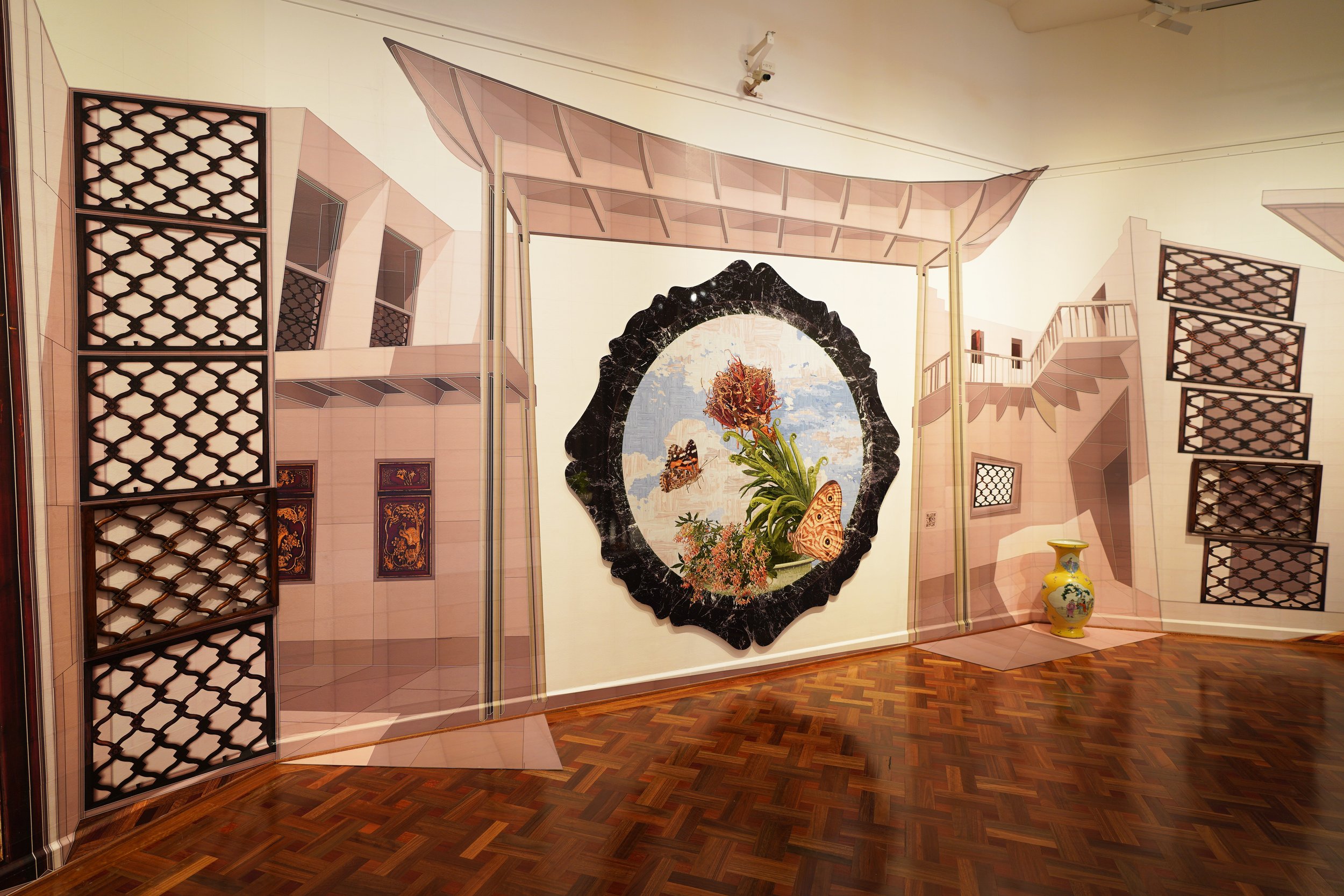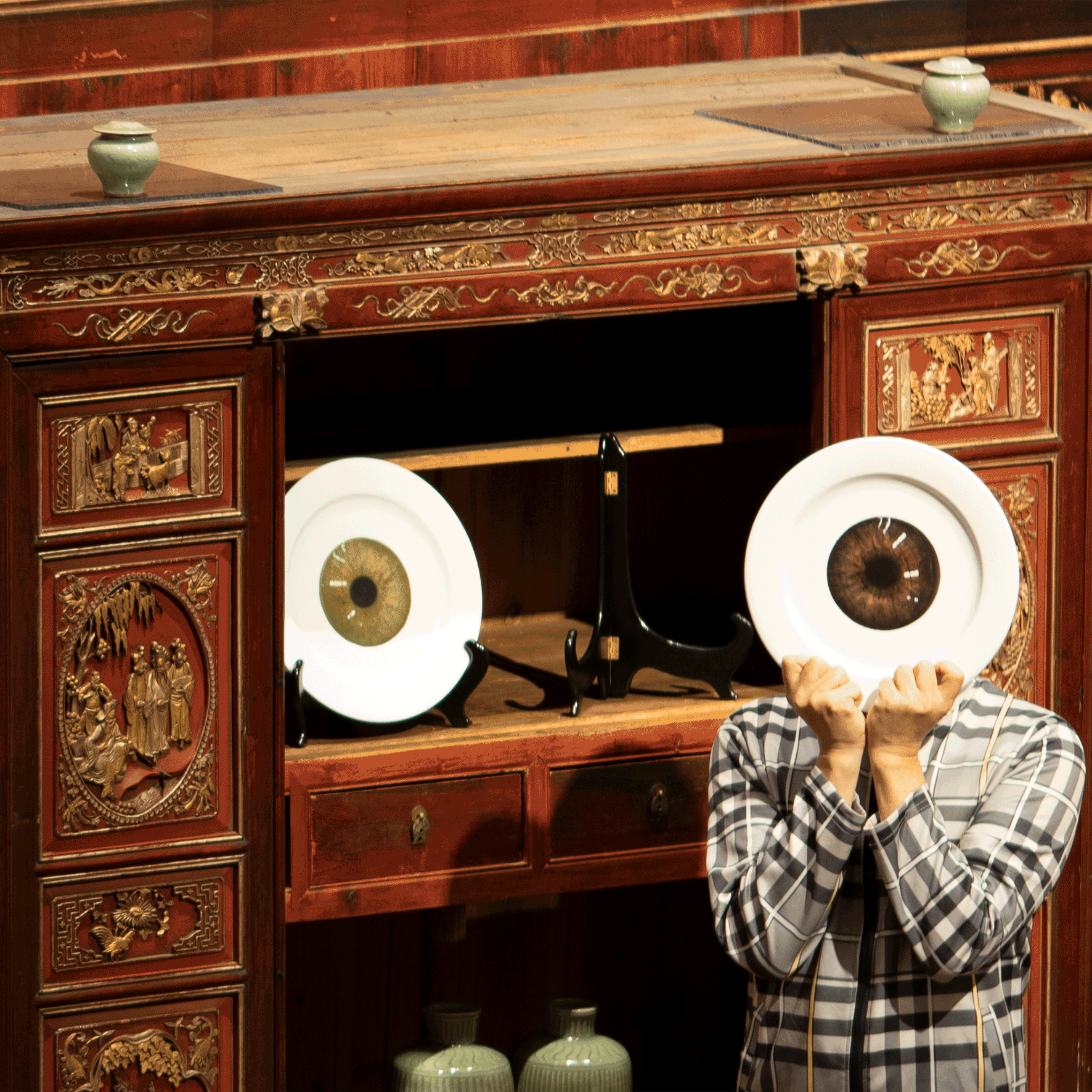
The Illawarra Pavilion
2021, Wollongong Art Gallery.
Confabulated out of 3,932 overlapping 80 gsm A4 photocopies (Laser Prints) the Illawarra Pavilion was installed in the main exhibition space of the Wollongong Art Gallery, over 28 consecutive days commencing on the 8th of February. Those active alongside us included Karan Singh, Milly Hyde, Anita Johnson, Desiree Tahiri, Nicci Bedson, Mignon Steele and Louise Brand.
Among the treasures of the Wollongong Art Gallery (WAG) is the Mann-Tatlow Collection of Asian Art. Donated to the gallery by William Tatlow and Gora Singh-Mann it includes antique bronzes, ceramics, furniture and textiles. Gift giving, bequests and other acts of generosity are important expressions of Civic commitment. As a vessel for individual identity the Civic is malleable and can be shaped by idealism and volition, shared with others without contriving to reduce individual difference to the transparent. A Civic identity enables participation and confluence without producing an amalgam in which individuality is lost though dissolution.
WAG provided a residential studio and supported our access to the Mann-Tatlow collection. We were allowed to photograph the surfaces of rare pieces of furniture and a selection of their sumptuous, gilded 19th century frames. From these high-resolution photographs, we were able to build pallets and to alter the scale, tonality and colour of the details of the furniture. Mise en scènically (re)incorporating them into a feed-back loop of their own (altered) materiality.
Sampling and dubbing are important processes for us as they support our continuing exploration of Spolia, an ancient and widespread practice (spoliation) whereby stone and other materials used in a built structure are carried away to be used elsewhere. Whilst it has obvious practical and ideological implications, we are more interested in its magical and spiritual potential. We are inspired by how musicians use dubbing and remixing in a similar way, modelling our engagement with spolia on their work. Eminem’s sampling of Dido’s Thank You (1998) for Stan (2000) is a significant reference point for us.
We were able to commission Subject biographies for the items from the Mann-Tatlow Collection included In the Illawarra Pavilion from the South Coast’s Writers Collective. Embedding them in the illusionary architecture of the Illawarra Pavilion alongside the Object biographies compiled by WAG’s Collection Manager Louise Brand. Both reflections of the artefact, that of it in the world of transactional records and of it in the imagination of creative writers living locally could be accessed through adjacent QR codes incorporated into various textures of the Pavilion’s interior.
The blending of inviolable museum objects and those brought in a store, therefore safe to handle or interact with, enabled the dancer and choreographer Ryuichi Fujimura to create a new dance work in which he could take and move with items from and within the Illawarra Pavilion. The ambiguation of cultural and monetary value is a consequent concern in our practice, as is contesting the increasing primacy of the later over the former in art and life.
The Illawarra Pavilion’s installation was a milestone in our understanding the distinction between enactment and representation in demarking the political image from the politics of the image. It was developed at the Clothing Store Artist’s Studios and with the financial assistance of a Project Grant from Create New South Wales.
From left: Fragment of back of Collection Item No. 2003.217 Chinese provincial lattice back cabinet early 18th century hard wood construction, Illawarra Still Life Dye Sublimation print on laser cut 4 mm Dibond, Collection item 2003.210 Early 20th century Porcelain floor vase, Collection Item No. 2003.217 Chinese provincial lattice back cabinet early 18th century hard wood construction.
Illawarra Flame Tree Dye Sublimation print on laser cut 4 mm Dibond cut in the shape of Collection item 2003.027 a 3rd Century BE Earthenware Pot with wall mounted doors from Collection Item 2003.218 carved blackwood cabinet.
From left: Collection 2003.217 Chinese provincial lattice back cabinet early 18th century hard wood construction, on top shelf (in Middle) Collection Item No. 2003.129 Tang Dynasty Amphora, either side Collection Item No. 2003.193 Late Edo Imari Ware Dishes. Middle Shelf Collection item 2003.027 a 3rd Century BE Earthenware Pot, Lower Shelf Collection Item No. 2003.163 Meiji Era Imari Ware Bowl.
From left: Bonsai in Collection Item No. 2003.235 20th Century China Planter, Video “The Invigilator”. (2022) Single track video 10.34. Videographer Ysia Song and Ricky Ye.
Collection Item No. 2003.215 Red lacquer and gilded pine cabinet, lower shelf Collection Item No. 2003.051 Late Ming Dynasty Longquan Vases, Upper shelf 2 IKEA dinner plates with decal stickers in the form of eyes.
Installation schema (detail) for Collection Item No. 2003.215 Red lacquer and gilded pine cabinet.
Cabinet door, wall mounted, from Collection Item No. 2003.215 Red lacquer and gilded pine cabinet.
Installation schema for Pagoda in the form of stacked altar tables and burial jars. Collection items 2003.043, 2003.052, 2003.213, 2003.216
Pagoda in the form of stacked altar tables and burial jars. Collection items 2003.043, 2003.052, 2003.213, 2003.216
Still from “She Will Be Watching” (2022) A dance work commissioned from Choreographer and Dancer Ryuichi Fujimura 12 minutes. In this work Ryuichi interacted with many of the Illawarra Pavilion’s elements.
“She Will Be Watching” (2022)
Dance Performance: She Will be Watching
Abridged film of a 12-minute interpretive choreography and dance performance “She Will be Watching” by Ryuichi Fujimura where he engages with the artefacts and navigates the spatiality of the Illawarra Pavilion.










